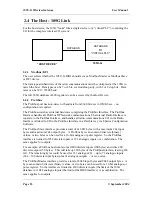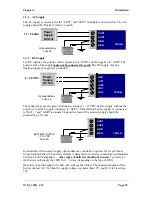
105U-G Wireless Gateway
User Manual
Page 23
© September 2004
2.4
The Host - 105G Link
For the host device, the 105G "looks" like a single device (or a "virtual PLC"), containing the
I/O for the complete wireless I/O system.
DATABASE
I/O
"VIRTUAL PLC"
DATA-BUS
“HOST DEVICE”
105U-G
2.4.1
Modbus / DF1
The user selects whether the 105U-G-MD1 should act as a Modbus Master or Modbus Slave
or DF1 device.
The data type and baud rate of the serial communications must be configured at the 105G to
match the host. Data types can be 7 or 8 bit, even/odd/no parity, with 1 or 2 stop bits. Data
rates can be 300 - 19200 baud.
The full 105G database (4300 registers) can be accessed by the Host Device.
2.4.2
Profibus
The Profibus port has auto-detect of baud rate from 9600 bits/sec to 12Mbit/sec - no
configuration is required.
The Profibus units have internal hardware comprising the Profibus Interface. The Profibus
Interface handles all Profibus DP Network communications. The internal Radio Interface is
separate to the Profibus Interface, and handles all radio communications. I/O in the Radio
Interface is linked to I/O in the Profibus Interface in a flexible way via ESeries Configuration
Software.
The Profibus Slave interface provides a total of 416 I/O bytes, with a maximum 244 input
bytes and maximum 244 output bytes. A Profibus byte can contain 8 discrete (binary)
values, or two bytes can be used for a 16-bit analogue or pulse register. So the Profibus
interface is limited to 1952 discrete inputs or 122 analogue inputs or a combination. The
same applies for outputs.
For example, a Profibus host wants to read 800 discrete inputs (100 bytes) and write 400
discrete outputs (50 bytes). This will take up 150 bytes of the Profibus Interface, leaving 266
left. The remaining bytes could be used for 133 analogue I/O - up to 72 analogue inputs
(244 – 100 discrete input bytes) plus 61 analogue outputs - or vice-versa.
The Profibus Master interface provides a total of 2048 input bytes and 2048 output bytes. A
byte can contain 8 discrete (binary) values, or two bytes can be used for a 16-bit analogue or
pulse register. So the interface is limited to 4300 discrete inputs (the limit of the 105G
database) or 1024 analogue inputs (the limit of the HMS interface) or a combination. The
same applies for outputs.
















































